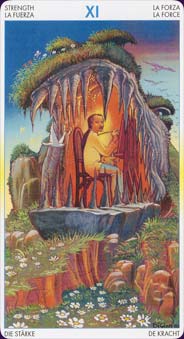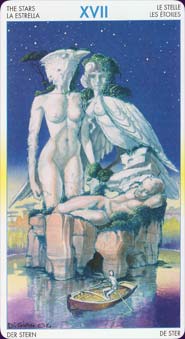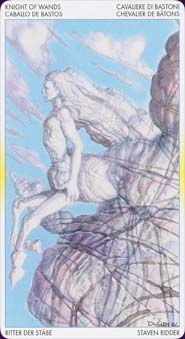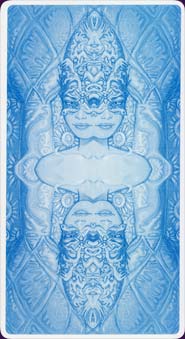Tarot of Metamorphosis Deck Review
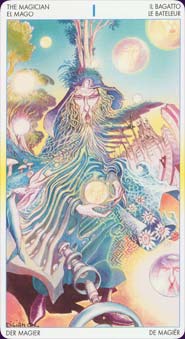
Creators: Massimiliano Filadoro, Luigi di Giammarino
Publisher: Lo Scarabeo 2005
Tarot of Metamorphosis illustrates the transformation of beings or objects into something else. The 78 cards are somewhat surreal and the art ranges from dreamlike fantasies to futuristic anime art.
Retailers
See Price at Amazon.comSee Price at Amazon.co.uk
Tarot of Metamorphosis Review by Cerulean
Dual review of the Tarot of Metamorphosis by Massimiliano Filadoro & Luigi di Giammarino, and the Dream Cards by Isa Donelli & Luigi Di Gianmarino.
A Pairing of Metamorphosis and Dreams
The poetic pairing of names in this title is more than just a pretty pair of decks. Sometimes when we are bored with tarot reading alone, or at a loss because we just bought decks that seem to be so 'way out there,' a creative answer is to do a mixed deck reading...even if there is a mis-match between the tarot and oracle. I present an example of a mismatch of a tarot and an oracle can add zest and enjoyment to the infinite possibilities of a card reading.
I'm starting small and I wanted to show you possibilities in these two very creative decks.
Now I've seen other reviewers from the U.S. note that Lo Scarabeo (LS) decks might give readers some pause. The considerations might be because the comic book style or the settings may not be as friendly to sensitive audiences. Those who don't like mixed male and female settings where the characters lack clothing or dislike moody pictures may not find these two decks as pretty as I do. I would not use these decks for children or the especially sensitive audience.
These are innovative and surrealistic decks that I would recommend for creative readers. The artist Luigi Di Giammarino actually painted the images in both decks. This helped me to see the decks as more alike, less of an odd couple. I was particularly interested in using both decks in a combined reading. This is a twist from Valerie Sim's "Comparative Tarot" method of doing readings with similar art. In this case, both are 78 card decks, one using a standard tarot structure and the other, a creative oracle card structure.
The colors and styles of images for both decks are done beautifully to me. There's a fluid weave of colors. If I wanted to paint such brightness, I would have to load my brush with a full sweep of pure pigment. I like how the colors chosen for the decks seem flattering to their unusual images. I found a balance of bold and soft images that seem suitable for doing readings for men and women. I also like the backgrounds-- crisp white for Metamorphosis and sky blue for Dreams.
One can tell a LS title by those typeset words on the corners in six languages, thin outline borders and in both decks, backs with a double-sided image.
Some creative readers or intuitive sorts do not want the creative images in their decks explained. They will love the mystery of something different. (If so, stop here.) But if you are like me, trying to analyze or explore the decks, perhaps these following notes would be helpful. I'm going to write this as if you were facing me or looking over my shoulder in a small reading.
I've learned on a discussion forum that the originator of many LS deck ideas is Pietro Alliegro, a modest and former magician. While my own ideas could be imaginative, I've thought often that I detected something of the entertainer in LS creative theme decks:
- Humor
- Delight in stretching boundaries
- Wink and nod to historical deck patterns
In Metamorphosis, one example of humor and delight is the enchantress Circe as a Queen of Cups. She is surrounded with adventurers transformed into pigs. Yes, the Queen of Cups can grant your longed for desires, but she also might also might grant your just desserts for your behavior.
This is where I see the wink and nod seem to come into play. While this is briefly touched on in the little white book, the assumption is that you know tarot meanings. Many LS decks seem to be in a cartomancy style that predates the 1910 Rider Waite Smith. People who enjoy Ms. Mary Greer's texts will refer to this as the Continental style of historical decks.
A brief explanation of this would show in the order of the trumps in Metamorphosis: Justice is number eight; Strength is number eleven, and the Fool is placed at the end of the other 22 major arcana sequence. Some of the books or booklets that come with Italian historical reproductions use this ordering. The authors who write in this language do not find this odd when also creating new decks.
But someone used to American or English-language 20th and 21st century decks might feel slightly confused-a standard deck of RWS majors seem to start with the Fool, and Strength as Eight, then Justice as Eleven. Again, this is what someone is used to, not necessarily right or wrong.
Metamorphosis's instructions are by Massimiliano Filadoro. There's an elusive depth behind the guidelines in the LWB that I am learning. I like what I see in the text.
The LWB suggests those interested to read on the theme of magical transformation from classics, ranging from Ovid, Robert Graves to Franz Kafka's short story (Gregor, the man who turned into a beetle) to Lewis Carroll (Through the Looking Glass). I would add that if you are a fan of older sci-fi, Ray Bradbury and Isaac Assimov also have transformative and imaginative stories with that blend of whimsy, curious twists and sometimes a pithy moral.
While we're looking at irony and humor, I'd like to also bring up the Dream Cards. I see the art first as an ironic touch to a range of interpretations from old fashioned decks. For instance, cards labeled Sibilla or Lenormand can have a similar concept assigned to a picture of a 'Dog'. The simple keywords are fidelity, loyalty. In terms of the Dream Cards, the suggested meanings are companionship and harmony.
I've seen different dream cards and books suggest that the readers distill their complex dreams into simple and associative concepts. This suggests that a dreamer will focus on an overall theme to explore their night imaginings.
I've seen complex dream card systems, which don't really work with me. Instead, I would rather have a simpler system that allows me more fluid work with dream interpretation. I don't tell fortunes or write or illustrate my dreams - but I do like to take what I remember as a starting point for suggestive readings. More like picking up a certain mood or discovering a small point of reference to explore.
People who do intensive dream analysis or are trained to focus on their inner perspectives to a high degree could use a card deck. Or they might find it too limiting... For me, someone who likes tarot and creative card art, these cards are handy and complement the art in the Metamorphosis tarot deck.
Isa Donelli wrote the instructions for the Dream cards and they also are guidelines to begin to make sense of the art and concepts behind the cards. I've seen Isa Donelli's writing in other Italian card decks. I find his work is succinct and familiar with many different creative decks.
In combination of using the cards and illustration, let me return to the image that uses the dog as a keyword concept. The dog illustration shows a person and dog images floating, one attached to a leash. The picture can seem like good companionship and harmony, but also works with the reverse interpretation of extravagance and discontinuity. The artist Giammarino likes compelling images. I see a depth of shadow and sophisticated use of linework and pattern in each illustration.
Let's say I did a two-card reading, one card from Metamorphosis and one from Dream cards. I thought of a dream chasing a dog on a leash, a pet that belongs to my nephews. I picked that card and saw the positive meanings of harmony and family companionship. But in terms of negative suggestions, there's extravagance and discontinuity...hmm. That isn't quite right to me.
So I pair it with a card pull from Metamorphosis and there's the Queen of Cups. - an intelligent and intuitive woman who can predict change. Circe welcomed others, but didn't allow them to cross the line with her. In one retelling of the tale, the moral to the guests was to restrain your greed as a guest in other's home.
While my original dream seemed to be about chasing the dog, here I sense 'discontinuity' in terms of my ideas of the Queen of Cups and the fleeing animal. The vitality and joy of the dog in the dream makes me smile: the dog follows her heart, despite the leash. But I cannot keep up with her energy. The Queen of Cups doesn't always welcome the disruption; yet the energy of creation will not always be harmonious. How to deal with the rough and tumble of young beasts? The best that I can hope is to by using my strength and heart, trying to consistently guide the energetic flow. Perhaps I should check out the Strength card for ideas...
I see this reading of two cards is not about neat and elegant solutions as if I used one deck alone. It makes me eager to do a bit more with these two cards, see if I can expand the reading out and come up with more ideas. These types of cards bring in so many different ideas to our reading table. Perhaps they will inspire you to go farther and deeper into exploring your own ideas for metamorphoses and dreams.
Tarot of Metamorphosis Review by Kate Hill
"Being aware of metamorphosis is… the sign of the possible Metamorphosis of the conscience. This deck was designed as a key for opening the treasures of that inexhaustible reservoir of creativity that anxiously lies in our unconscious."
The Tarot of Metamorphosis is a deck of change, where almost every one of its 78 cards pictures a being in process of transformation into something else. Collectively, Luigi Giammarino’s artwork is a creative dreamscape loosely confined by the tarot structure.
The deck’s structure is European, with Strength at XI and Justice at VIII, and its suits are labeled Chalices, Pentacles, Wands and Swords. It definitely does not use standard Tarot symbols on its cards, but they are linked in concept if not in imagery. In the majors there are occasional flashes of the familiar in the Fool, Emperor, Hermit and Hanged Man.
Each of the minor arcana suits has also been transformed. Chalices, The Metamorphoses of Myth, are linked with Greek myths and legends. Pentacles, The Posthumous Metamorphoses, are 'an era of uniting flesh and metal'. Swords are The Metamorphoses of Thought, and are illustrated by characters and stories from art and literature – Dracula, Dante’s Inferno, Alice in Wonderland, Kafka. The Wands, The Metamorphoses of Nature, are inspired by the opaque concept that 'there is no clear division between the natural kingdoms and the elements dance interwoven in the spiritual flurry of ceaseless evolution'.
All of the cards have a complex, surreal artistry, filled with great washes of bright colour. It’s a Tarot of the imagination, of dreams and shifting shapes, things in the process of changing or merging into something else. It’s not always attractive, but it is always creative. At times a card appears futuristic (particularly in the Pentacles), other times literature and myths are the inspiration. I particularly liked the Hierophant (unusually), where a woman stands in flowing water, in front of a rock cliff with the shape of a man’s face; Strength, where a man paints at an easel inside a stone mouth/cave with teeth like a hippo, and here is a warm light behind him inside the cave. The Knight of Wands is my favourite from the minors, where a centaur appears to be emerging from, or part of, a cloud.
Being a Lo Scarabeo deck, the faces of the cards have a border - white for this deck - containing the card title in six languages. The backs of the cards have a blue (double-ended, and therefore reversible) design of an alien-looking woman with human eyes, lips and shoulders and a head the shape of a bishop’s mitre.
The companion booklet, by Massimiliano Filidoro, is fairly typical for Lo Scarabeo - printed in English, French, Italian, Spanish and German and with a short intro for the deck’s concept – but has individual, phrased meanings for each card rather than keywords. At the back is the original spread, ‘Divining Method: the Chrysalis’, which has five cards and looks like the left half of a Celtic Cross spread, and a list of recommended reading.
10 of Pentacles – Posthumous metamorphosis. Transformation that surpasses the human, Acquired power will be dispersed if it is just accumulated without using it for higher purposes.
XI – Strength – The Metamorphoses of Energy. Even the most frightening and aggressive force can be sublimated through metamorphosis. Strength helps us correctly channel the lowest energies, transforming and purifying them. Be careful of excessive trust.
It’s designed as a Tarot for change, for shaking up your life and bringing in that transformative energy. The Tarot of Metamorphosis and its dreamlike perspective will definitely something different to your Tarot readings.
Complete Details of Tarot of Metamorphosis
Also known as Tarot of Methamorphosis
Creators: Massimiliano Filadoro, Luigi di GiammarinoPublisher: Lo Scarabeo 2005
Deck Type: Tarot Deck
Cards: 78
Major Arcana: 22
Minor Arcana: 56
Deck Tradition: Mixed
Minor Arcana Style: Unique Scenes Without Suit Symbols
Suits: Chalices, Swords, Wands, Pentacles
Court Cards: Knave, Knight, Queen, King
The Fool is 0
Strength is 11
Justice is 8
Card Size: 2.60 x 4.72 in. = 6.60cm x 12.00cm
Card Language: Spanish, Italian, German, French, English, Dutch
Card Back: Unknown
Companion Material: Little white booklet in five languages.
Rating: 14/20 or
Similar Decks to Tarot of Metamorphosis
Theme: Dream, Fantasy, SurrealCreator: Sacred Sites Tarot, Samurai Tarot, Shaman Tarot, Tarot Mucha, Tarot of Reincarnation, Vice-Versa Tarot, Yoga Tarot by Massimiliano Filadoro
< Previous Deck · Back to Top · Next Deck >
Home > Tarot Reviews > Tarot of Metamorphosis Review

